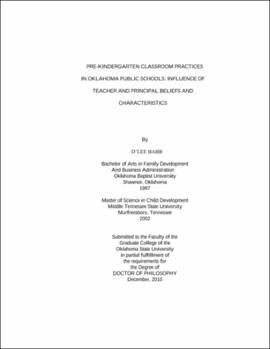| dc.contributor.advisor | Hubbs-Tait, Laura | |
| dc.contributor.author | Babb, D'Lee | |
| dc.date.accessioned | 2013-12-10T18:04:16Z | |
| dc.date.available | 2013-12-10T18:04:16Z | |
| dc.date.issued | 2010-12 | |
| dc.identifier.uri | https://hdl.handle.net/11244/7693 | |
| dc.description.abstract | Scope and Method of Study: The purpose of this study was two-fold: 1) to examine the relations between pre-kindergarten (pre-K) teachers' characteristics, belief in developmentally appropriate practices (DAP), and DAP classroom practices and 2) to examine the relations between principals' characteristics, DAP and testing beliefs, and preferred pre-K classroom practices. Sixty-six principals and 63 pre-K teachers from public schools in small districts (districts with only one elementary school) in Oklahoma participated. Principals and teachers completed questionnaires containing DAP, demographic, and time allocation information. Data were analyzed using correlations and regressions. | |
| dc.description.abstract | Findings and Conclusions: In the study of teachers, number of child development courses taken (r=-.29) and number of years experience teaching pre-K (r=.30) were related to DAP beliefs. The relation of DAP beliefs to DAP classroom practices was moderated by teacher's beliefs in the importance of obedience; DAP beliefs and practices were positively related for teachers with lower belief in the importance of child obedience. In the study of principals, principals' ECE courses taken (r=.36), ECE state test certification (r=.59), elementary certification (r=.34), number of years as a principal (r=-.25), years teaching preschoolers (r=.35), experience teaching 4th to 6th grades (r=-.35), and years teaching 4th to 6th grades (r=-.30) were related to principals' beliefs in DAP. Principals' ECE state certification (r=.41), ECE courses taken (r=.27), and years teaching 4th to 6th grades (r=-.33) were related to preferred DAP classroom practices and experience teaching 1st to 3rd grades (r=-.29) was related to use of workbooks and worksheets. DAP beliefs (r=.60) were significantly related to preferred DAP classroom practices. Testing beliefs were not related to principal characteristics or preferred classroom practices. The relation between the number of early childhood courses taken by principals and preferred DAP classroom practices was mediated by principals' beliefs in DAP. | |
| dc.format | application/pdf | |
| dc.language | en_US | |
| dc.rights | Copyright is held by the author who has granted the Oklahoma State University Library the non-exclusive right to share this material in its institutional repository. Contact Digital Library Services at lib-dls@okstate.edu or 405-744-9161 for the permission policy on the use, reproduction or distribution of this material. | |
| dc.title | Pre-kindergarten classroom practices in Oklahoma public schools: Influence of teacher and principal beliefs and characteristics | |
| dc.contributor.committeeMember | Henry, Carolyn | |
| dc.contributor.committeeMember | Atiles, Julia | |
| dc.contributor.committeeMember | Norris, Deborah | |
| dc.contributor.committeeMember | Perry, Katye | |
| osu.filename | Babb_okstate_0664D_11246.pdf | |
| osu.accesstype | Open Access | |
| dc.type.genre | Dissertation | |
| dc.type.material | Text | |
| dc.subject.keywords | classroom practices | |
| dc.subject.keywords | developmentally appropriate practices | |
| dc.subject.keywords | early childhood education | |
| dc.subject.keywords | principals | |
| dc.subject.keywords | public schools | |
| thesis.degree.discipline | Human Environmental Sciences | |
| thesis.degree.grantor | Oklahoma State University | |
